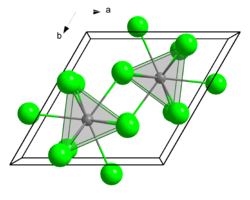Terbium(III) chloride
| |||
| Names | |||
|---|---|---|---|
| Other names
terbium trichloride | |||
| Identifiers | |||
| 10042-88-3 | |||
| 3D model (Jmol) | Interactive image | ||
| ECHA InfoCard | 100.030.108 | ||
| EC Number | 233-132- | ||
| PubChem | 61458 | ||
| UNII | 804HI855F8 | ||
| |||
| |||
| Properties | |||
| TbCl3 | |||
| Molar mass | 265.2834 g/mol | ||
| Appearance | white powder | ||
| Density | 4.35 g/cm3, solid | ||
| Melting point | 558 °C (1,036 °F; 831 K) | ||
| Boiling point | 180 to 200 °C (356 to 392 °F; 453 to 473 K) (in HCl gas atmosphere) | ||
| soluble | |||
| Structure | |||
| hexagonal (UCl3 type), hP8 | |||
| P63/m, No. 176 | |||
| Tricapped trigonal prismatic (nine-coordinate) | |||
| Hazards | |||
| EU classification (DSD) |
not listed | ||
| Related compounds | |||
| Other anions |
Terbium(III) oxide | ||
| Other cations |
Gadolinium(III) chloride Dysprosium(III) chloride | ||
| Except where otherwise noted, data are given for materials in their standard state (at 25 °C [77 °F], 100 kPa). | |||
| | |||
| Infobox references | |||
Terbium(III) chloride (TbCl3) is a chemical compound. In the solid state TbCl3 has the YCl3 layer structure.[1] Terbium(III) chloride frequently forms a hexahydrate.
Hazards
Terbium(III) chloride causes hyperemia of the iris.[2] Conditions/substances to avoid are: heat, acids and acid fumes.
References
This article is issued from Wikipedia - version of the 9/28/2016. The text is available under the Creative Commons Attribution/Share Alike but additional terms may apply for the media files.

_2.png)